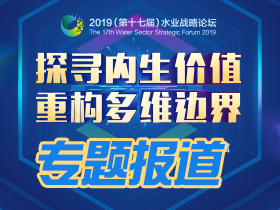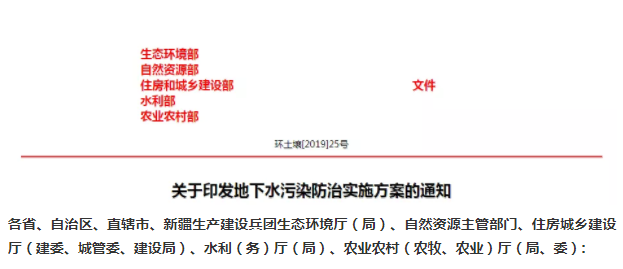 联系我们 : 400-822-5278
联系我们 : 400-822-5278
FAGGIOLATI in China
![]()
4008225278
hotline@faggiolatipump.com
http://www.faggiolatipump.com

Recently, the Ministry of Ecology and Environment, the Ministry of Natural Resources, the Ministry of Housing, Urban and Rural Construction, the Ministry of Water Resources and the Ministry of Agriculture and Rural Areas issued circulars on the implementation plan of groundwater pollution prevention and control. It is proposed that by 2035, groundwater environmental quality will be improved and ecosystem functions will be basically restored.
Recently, the Ministry of Ecology and Environment, the Ministry of Natural Resources, the Ministry of Housing, Urban and Rural Construction, the Ministry of Water Resources and the Ministry of Agriculture and Rural Areas issued circulars on the implementation plan of groundwater pollution prevention and control.。
It is proposed that by 2020, a system of regulations and standards for prevention and control of groundwater pollution and a national groundwater environmental monitoring system will be established; the proportion of groundwater quality extreme difference in the whole country will be controlled at about 15%; typical groundwater pollution sources will be monitored and the trend of groundwater pollution will be curbed preliminarily. By 2025, regulations and standards system for prevention and control of groundwater pollution and national groundwater environment monitoring system will be established; the proportion of water quality of centralized groundwater drinking water sources in cities at prefecture level and above reaching or surpassing category III is about 85%; typical groundwater pollution sources will be effectively monitored and the trend of groundwater pollution intensification will be effectively curbed. By 2035, efforts will be made to improve the overall quality of groundwater environment and basically restore the ecosystem functions throughout the country.
n terms of the main tasks, the plan points out that it mainly focuses on the realization of the short-term objectives of "one guarantee, two construction, three coordination and four implementation", "one guarantee", namely, ensuring the environmental safety of groundwater-based drinking water sources; "two construction", namely, establishing the system of laws and standards for groundwater pollution prevention and control, and the national groundwater environmental monitoring system; "three coordination", namely, coordinating surface water and groundwater, soil and groundwater; Regional and site pollution prevention and control; "four implementations", that is, to implement the four key tasks set out in the Ten Rules of Water, to carry out investigation and evaluation, seepage control transformation, pilot repairs, sealing and backfilling.
The plan also proposes that the National Plan for the Prevention and Control of Groundwater Pollution (2021-2025) be formulated by the end of 2020.
The document reads as follows:
Provinces, autonomous regions, municipalities directly under the Central Government, Xinjiang Production and Construction Corps Ecological Environment Department (Bureau), Natural Resources Authority, Housing Urban and Rural Construction Department (Construction Committee, Urban Management Committee, Construction Bureau), Water Conservancy Department (Bureau), Agricultural and Rural (Agriculture, Animal Husbandry, Agriculture) Department (Bureau, Committee):
In order to implement the spirit of the important instructions of general secretary Xi Jinping on the prevention and control of groundwater pollution, and lay a solid foundation for the battle against pollution and ensure the safety of groundwater, the implementation plan of groundwater pollution prevention and control is hereby issued to you. Please conscientiously carry out the work and accelerate the work of groundwater pollution prevention and control.
Ministry of Ecology and Environment
Ministry of Natural Resources
Ministry of Housing, Urban and Rural Construction
Ministry of water resources
Ministry of Agriculture and Rural Areas
28 March 2019
Annex 1: Technical Requirements for Division of Groundwater Pollution Prevention and Control
I. Work Content
Considering the hydrogeological structure, vulnerability, pollution status, water resources endowment and administrative regionalization of groundwater, a groundwater pollution prevention and control zoning system is established, and groundwater pollution protection zones, prevention and control zones and control zones are delineated.
II. Scope of work
Provincial, municipal and county administrative regions shall be taken as the scope of evaluation.
III. Workflow
(1) Collecting data. According to the index system of groundwater pollution source load, vulnerability, function value and pollution status assessment, relevant data and data are collected, and necessary supplementary investigations are carried out.
(2) Assessment of load, vulnerability and functional value of groundwater pollution sources. According to the results of data analysis, the groundwater pollution source load zoning, groundwater vulnerability zoning and groundwater function value zoning are carried out by using the evaluation method of each index system.
(3) Assessment of the present situation of groundwater pollution. According to groundwater quality target, standard limit value and reference value (or background value), groundwater pollution status assessment is carried out. The main assessment indicators are "three nitrogen", "heavy metal" and organic matter pollution indicators, forming pollution distribution map.
(4) Division of groundwater pollution prevention and control zones. According to the use function of groundwater, the assessment results of pollution status, the load of groundwater pollution source, vulnerability and so on, it is divided into protection area, prevention and control area and treatment area, and the corresponding countermeasures and suggestions for groundwater pollution prevention and control are put forward.
See Guidelines for the Division of Groundwater Pollution Prevention and Control Areas (Trial Implementation). (Environmental Protection Letter No. 99, 2014).
Annex 2: Verification requirements for anti-seepage modification of gas stations
I. Scope of application
Gas stations in 31 provinces (districts and municipalities) throughout the country. Priority screening principles:
(1) Gas stations that have been renovated in the list;
(2) Gas stations built for more than 15 years;
(3) Gas stations with sensitive targets such as drinking water sources exist around them.
II. Major Tasks
Comparing with "Code for Design and Construction of Automobile Gas Station" (GB 50156), "Technical Standard for Leakage Prevention and Retrofit of Oil Tanks in Service" (GB/T 51344), "Steel-Glass Fiber Reinforced Plastic Double-Layer Buried Tank" (JC/T 2286), "Technical Specification for Buried Glass Fiber Reinforced Plastic Double-Layer Tank in Gas Station" (SH/T 3177) and "Technical Guide for Prevention and Control of Groundwater Pollution in Gas Station"( To verify that the underground tank of the gas station has been upgraded to double-deck tank or the installation of anti-seepage tank has been completed.
III. Ways of verification
(1) On-site verification. Fill in the basic information form of the gas station, and verify the installation and operation of the leakproof equipment of the double-deck tank and the seepage-proof tank.
(2) Data verification. The information provided includes but is not limited to the following: equipment and materials procurement contracts and invoices, construction plans, construction drawings, acceptance reports, engineering supervision reports, acceptance (record) documents of relevant management departments, construction image data, etc.
(3) Inquiry and verification. In the process of verification, questions on doubtful issues should be promptly inquired, and the subject to be verified should be explained and relevant supporting materials should be provided.
Annex 3: Technical Requirements for Publishing List of Groundwater Pollution Sites
I. Scope of List Screening
Chemical production enterprises, industrial agglomeration areas, mining areas, tailings reservoirs, hazardous waste disposal sites, landfills and other sites that cause groundwater pollution.
II. List Screening Principles
(1) The surrounding water source is polluted due to the pollution of the site;
(2) Investigation and assessment of groundwater environmental conditions or detailed investigation of soil pollution have been carried out, and it has been found that man-made pollution is indeed unacceptable and health risks are unacceptable;
(3) Groundwater pollution accidents have occurred or there has been strong public reaction.
III. Ways of List Publication
Provinces (districts and municipalities) shall publish annual lists of groundwater contaminated sites with high environmental risks and serious impacts on public health in their respective administrative areas on relevant websites or public information platforms.
IV. Publication of Contents
The names of polluted sites, the districts and counties they belong to, the investigation boundaries and areas, the names of the major pollutants they produce, the situation of exceeding the standards, the objectives of remediation (prevention and control), the measures for remediation and the progress of remediation should be made public to the society in accordance with the law, and they should be subject to supervision on their own initiative.